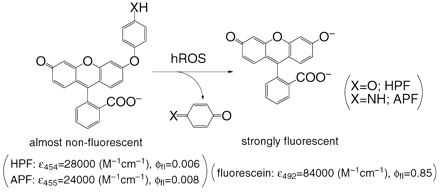GENTAUR - Research solutions for the academic, biotechnology and pharmaceutical industries
![]()
hROS Detection Kit ™
Fluorescent Highly Reactive Oxygen Species Detection Kit |
| Key Benefits: |
- Quenched Cell permeable dye.
- One Step, No wash Homogenous assay.
- Adaptable to High throughput assay platforms.
- Can monitor multiple time points to follow real time kinetics.
- Non-destructive cell based assay allows monitoring of additional parameters.
- Applications - Fluorescence Plate Reader / Fluorescence Microscopy / Flow Cytometry
|
| Introduction: |
A new novel probe, Aminophenyl fluorescein (APF), developed by Tetsuo Nagano et. al. (1), is a general selective indcator for the detection of highly Reactive Oxygen Species (hROS). The probe has little reactivity towards other ROS such as: singlet oxygen (O21), superoxide (O2– •), hydrogen peroxide (H2O2), nitric oxide (NO•), and alkyl peroxide (RO2•) (see table below)1. APF is a cell permeable indicator that can be used to detect Hydroxyl Radical (.OH), Peroxynitrite: (ONOO- ) and hypochlorite (-OCl) production in cells.
Several fluorescent probes such as 2’,7’-dichlorodihydrofluorescein (DCFH) and di-hydrorhodamine123, have been developed to detect Reactive Oxygen Species (ROS). As Hempel and co-workers (2) have indicated, DCFH and di-hydrorhodamine123 can react with various ROS and oxidizing species such as hydrogen peroxide, hypochlorite, superoxide, nitric oxide, ferrous ion, and others. These probes should be considered as detecting a broad range of ROS (2). |
| Assay Principle: |

| Product |
Catalog # |
Contents |
Size* |
| hROS Detection Kit |
FLAPF 100-2 |
APF 1 vial |
150 |
|














